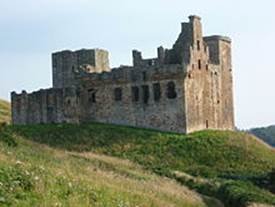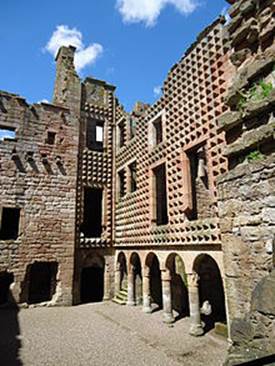
Best viewed in
Internet Explorer
PDF
Back to

Updated
07/11/2016 |
Clan Chrichton's Dark History
About
15 miles south-east of Edinburgh lies the hamlet of Crichton. A few
hundred yards west is Crichton Collegiate Church and south of there the
ruins of the formidable Crichton Castle overlook the headwaters of the
river Tyne.

The first of the family on record is Thurstonus de Crichton who
witnessed the foundation charter of the abbey of Holyrood in 1128. His
descendants' names appear on charters over the next centuries and Thomas
de Crichton joined the rest of the aristocracy of Scotland in signing
the Ragman Roll of 1296 submitting to Edward I. One of his sons married
the heiress to the barony of Sanquar in Dumfriesshire and spawned a
powerful dynasty in the South West.
The senior line of the family reached the apogee of its power in the
early 15th Century with William Crichton, who was knighted by James I in
1424. When the king was assassinated in 1437, Crichton was Governor of
Edinburgh Castle, Master of the Royal Household and, soon after,
appointed himself Lord Chancellor. The Earl of Douglas, the most
powerful noble in the nation, became Lieutenant General of the Realm on
behalf of the six year old James II.
Alexander Livingstone, who was Governor of Stirling Castle, and Crichton
took it in turns to kidnap the young king and hold him as the ultimate
source of power. When Douglas died, the two of them lured his 16 year
old successor and his brother to Edinburgh Castle, under the pretext of
dining with the young monarch, and executed them at the Black Dinner –
the inspiration for the Red Wedding in George R. R. Martin’s Game of
Thrones.
Four generations on, Sir James Crichton inherited the barony of
Frendraught, in Banffshire, in the midst of territory dominated by the
Gordon earls of Huntly. Their relationship was uneasy, culminating in a
dispute in 1630 when Gordon of Rothiemay was killed resisting the
execution of a legal warrant in Crichton's favor. The Gordons were
preparing to lay waste to Frendraught in revenge until the intervention
of the Privy Council, which brokered a peace between the parties that
was sealed at the Bog of Gight – the seat of the Marquis of Huntly.
The Viscount of Aboyne, heir to the Marquis, and Gordon of Rothiemay's
son provided an escort for Crichton back to his castle at Frendraught,
where they were entertained and stayed overnight. At about midnight a
fire broke out in the tower where the guests were sleeping. The
viscount, Rothiemay and four attendants were burnt alive. Onlookers
could see them trapped behind the iron bars protecting the windows.
The fire was almost certainly an accident but nobody believed it.
Frendraught was tried and acquitted but his lands were considered fair
game. With the tacit approval of the Gordons, caterans from across the
Highlands came to plunder the estate time after time. The family was
reduced to poverty and in seventy years was ‘stripped of all and
extinguished.’ The head of the Dumfriesshire branch of the family, Sir
Robert Crichton, was created Lord Sanqhuar in 1487 after the battle of
Lochmaben Fair. James Crichton, descended from this family, was born in
1560 and brought up at Clunie Castle, situated on an island in its own
loch near Dunkeld. He went to St Andrews University and graduated with
two degrees aged 15. At 20 he went abroad where he earned the soubriquet
‘The Admirable Crichton.’ There is enough hard evidence to show that he
was quite exceptionally gifted. His reputation was embellished by his
admirers, but ‘by the age of twenty, he was not only fluent in, but
could discourse in (both prose and verse) no fewer than twelve
languages, as well as being an accomplished horseman, fencer, singer,
musician, orator, and debater.’ Noted for his good looks as well as his
refined social graces, he was considered to have come closest to the
ideal of the complete man.
After intellectually besting halls full of learned professors in France
and Italy and killing assorted villains in duels, he became tutor to the
son of the Duke of Gonzago. In Mantua a gang attacked him; he beat all
but one, who turned out to be his pupil. Crichton stayed his sword and
was stabbed in the heart by his jealous student. He was 21.
|
Crichton Castle comprises four
contiguous buildings arranged around an inner courtyard. The
14th century tower lies at the east of the castle, and has a
vaulted basement with timber entresol, and a vaulted hall above,
although the south-west corner of the tower has collapsed. To
the west of this tower was a barmkin. William Crichton extended
the castle in the early 15th century, building a second tower to
the south, forming a strong L-plan, with the gate between the
two towers. The south tower was entered by a door in the center,
with vaulted cellars either side. Two halls occupied the first
and second floors. In the later 15th century a west block was
added, with a six-story tower at the south-west, containing
several bed rooms with garderobes. A stair in the south block
gave access to these rooms. The north range was added at this
time, closing the courtyard, but this section was heavily
rebuilt in the following century. |

|
|


